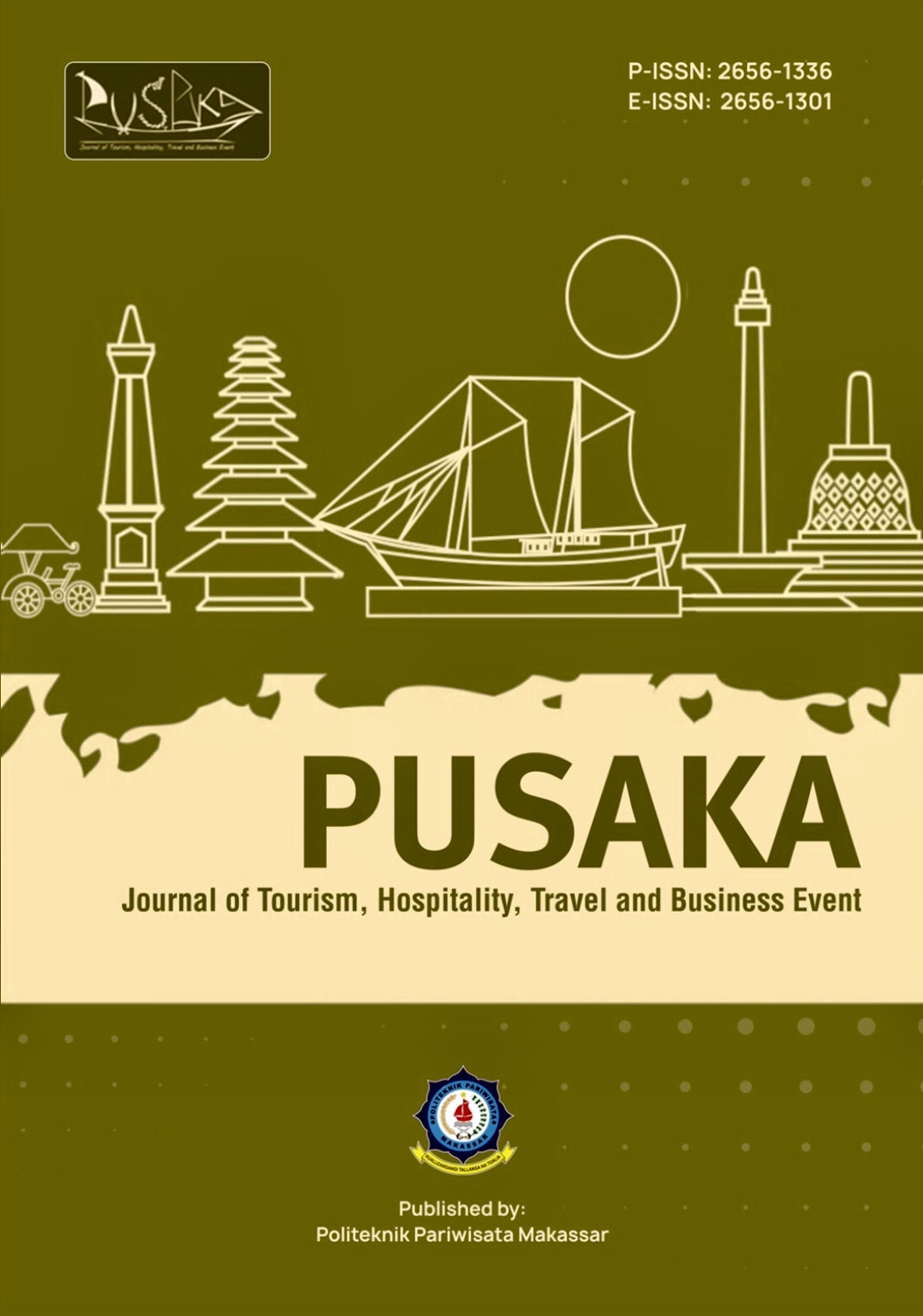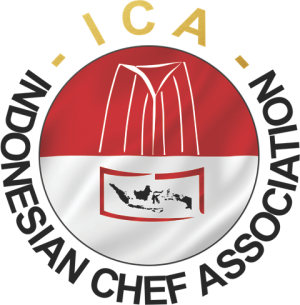Culinary Tourism in Kutawaringin (Bandung): Structural Relationship Between Food Quality, Tourist Perceptions, And Culinary Tourism Satisfaction
DOI:
https://doi.org/10.33649/pusaka.v6i1.310Keywords:
Culinary, Tourism, Perception, Satisfaction, KutawaringinAbstract
This study assessed tourist satisfaction with culinary tourism in Kutawaringin District, Bandung Regency. A quantitative descriptive approach was used to reveal tourist perceptions and the impact of food quality on culinary tourism satisfaction in Kutawaringin District, Bandung Regency. Data was collected through interviews, observation, and documentation. A random sample of tourists completed the questionnaire. The study sample consisted of 50 individuals who participated in in-depth interviews. It is important to note that these evaluations are based solely on objective criteria and do not include subjective opinions. Lemon tea was found to be the most popular food item, while tourists rated the seller's service highest at 74%. Food hygiene received a rating of 71%; food tastes 60%; affordability of the seller's location 57%; food quality and promotion 46%; and food prices 40%, all with a fair assessment. Collaboration is necessary among tourism managers and stakeholders to make Kutawaringin a supporting factor for the Bandung Destination. This requires consideration of various factors, including food prices, packaging quality, and promotion
References
Alonso, E. B., Cockx, L., & Swinnen, J. (2018). Culture and food security. Global Food Security, 17, 113–127. https://doi.org/10.1016/j.gfs.2018.02.002
Anggraini, O. (2021). The Partnership of Tourism Stakeholders in Increasing Tourism Competitiveness in Bantul District. https://doi.org/10.4108/eai.17-7- 2019.2301676
Anton Martin, C., Camarero Izquierdo, C., & LagunaGarcia, M. (2021). Culinary tourism experiences: The effect of iconic food on tourist intentions. Tourism Management Perspectives, 40. https://doi.org/10.1016/j.tmp.2021.100911
Ashaolu, T. J. (2020). Safety and quality of bacterially fermented functional foods and beverages: A minireview. In Food Quality and Safety (Vol. 4, Issue 3). https://doi.org/10.1093/FQSAFE/FYAA003
Bae, J. H., & Jeon, H. M. (2022). Exploring the Relationships among Brand Experience, Perceived Product Quality, Hedonic Value, Utilitarian Value, and Brand Loyalty in Unmanned Coffee Shops during the COVID-19 Pandemic. Sustainability (Switzerland), 14(18). https://doi.org/10.3390/su141811713
Balkir, P., Kemahlioglu, K., & Yucel, U. (2021). Foodomics: A new approach in food quality and safety. In Trends in Food Science and Technology (Vol. 108). https://doi.org/10.1016/j.tifs.2020.11.028
Camilleri, M. A. (2018). In Travel Marketing, Tourism Economics and Airline Products. In The Tourism Industry: An Overview (Issue October).
Chi, C. G. Q., Chua, B. L., Othman, M., & Karim, S. A. (2013). Investigating the Structural Relationships Between Food Image, Food Satisfaction, Culinary Quality, and Behavioral Intentions: The Case of Malaysia. International Journal of Hospitality and Tourism Administration, 14(2). https://doi.org/10.1080/15256480.2013.782215
Duarte Alonso, A., Kok, S., Vu, O. T. K., & O’Brien, S. (2023). Reconfiguring an Established Wine Tourism Destination: A Dynamic Capabilities Approach. International Journal of Hospitality and Tourism Administration, 24(5). https://doi.org/10.1080/15256480.2022.2055691
Ervina, E., Wulung, S. R. P., & Octaviany, V. (2020). Tourist Perception of Visitor Management Strategy in North Bandung Protected Area. Journal of Business on Hospitality and Tourism, 6(2). https://doi.org/10.22334/jbhost.v6i2.235
Galati, A., Testa, R., Schifani, G., & Migliore, G. (2023). Tourists’ motivation toward culinary destination choice: targeting Italian tourists. Journal of Foodservice Business Research, 26(4). https://doi.org/10.1080/15378020.2021.1948295
Han, S., Song, D., Xu, L., Ye, Y., Yan, S., Shi, F., Zhang, Y., Liu, X., & Du, H. (2022). Behaviour in public open spaces: A systematic review of studies with quantitative research methods. In Building and Environment (Vol. 223). https://doi.org/10.1016/j.buildenv.2022.109444
Hernández-Mogollón, J. M., Di-Clemente, E., & CampónCerro, A. M. (2020). Culinary travel experiences, quality of life and loyalty. Spanish Journal of Marketing - ESIC, 24(3). https://doi.org/10.1108/SJME-11-2019-0094
Hudson, S. (2011). Working together to leverage film tourism: Collaboration between the film and tourism industries. In Worldwide Hospitality and Tourism Themes (Vol. 3, Issue 2). https://doi.org/10.1108/17554211111123023
Jeon, H. M., & Yoo, S. R. (2021). The relationship between brand experience and consumer-based brand equity in groceries. Service Business, 15(2). https://doi.org/10.1007/s11628-021-00439-8
Jiang, Y., Lai, P., Chang, C. H., Yuen, K. F., Li, S., & Wang, X. (2021). Sustainable management for fresh food E-commerce logistics services. Sustainability (Switzerland), 13(6). https://doi.org/10.3390/su13063456
Jokom, R., Widjaja, D. C., Kristanti, M., & Wijaya, S. (2023). Culinary and destination experiences on behavioural intentions: an insight into local Indonesian food. Journal of Foodservice Business Research. https://doi.org/10.1080/15378020.2023.2229574
Kaur, S., & Kaur, M. (2024). Image of Local Cuisine in Emerging Gastronomic Destinations: Scale Review, Development, and Validation. International Journal of Hospitality and Tourism Administration, 25(1). https://doi.org/10.1080/15256480.2022.2092247
KEMENTERIAN PARIWISATA DAN EKONOMI KREATIF / BADAN PARIWISATA DAN EKONOMI KREATIF. (2024). Jaringan Desa Wisata Kementerian Pariwisata dan Ekonomi Kreatif. KEMENTERIAN PARIWISATA DAN EKONOMI KREATIF / BADAN PARIWISATA DAN EKONOMI KREATIF.
Kurnia, M. (2022). Pengembangan Wisata Kuliner Desa Bonjeruk sebagai objek daya tarik wisata di Desa Bonjeruk Kecamatan Jonggat Kabupaten Lombok Tengah (Doctoral dissertation, UIN Mataram).
Kurniawan, K., Suganda, D., & Lies Siti Khadijah, U. (2022). Dampak Wisata Religi Makam Eyang Kobul Ditinjau dari Aspek Ekonomi dan Sosial. Tourism Scientific Journal, 7(1). https://doi.org/10.32659/tsj.v7i1.164
Lane, R. P., Peterson, C. E., & Elliott, F. C. (2022). Feasibility of Using the Meadow Vole, Microtus pennsylvanicus to Bioassay the Nutritive Value and Culinary Quality of Some Carrot Inbred Lines and Hybrids1. Journal of the American Society for Horticultural Science, 94(2). https://doi.org/10.21273/jashs.94.2.96
Le Busque, B., Mingoia, J., & Litchfield, C. (2022). Slow tourism on Instagram: An image content and geotag analysis. Tourism Recreation Research, 47(5–6). https://doi.org/10.1080/02508281.2021.1927566
Lin, C. H., & Kuo, B. Z. L. (2016). The Behavioral Consequences of Tourist Experience. Tourism Management Perspectives, 18, 84–91. https://doi.org/10.1016/j.tmp.2015.12.017
Martina, C. D., Mananda, I. G. P. B. S., & Sudiarta, I. N. (2023). Quality of Culinary Tourism Products Influence Satisfaction and Loyalty of Tourists Visiting Puyung Inaq Esun Racing Rice Restaurant in Lombok. Devotion : Journal of Research and Community Service, 4(7). https://doi.org/10.59188/devotion.v4i7.513
Mohammad, N., Hanafiah, M. H., & Zahari, M. S. M. (2022). Heritage food consumption and experiential value influence Terengganu’s destination image and tourists’ behavioural intention. Journal of Heritage Tourism, 17(6). https://doi.org/10.1080/1743873X.2022.2110886
Olszewski-Strzyżowski, D. J. (2022). Promotional Activities of Selected National Tourism Organizations (NTOs) in the Light of Sustainable Tourism (Including Sustainable Transport). Sustainability (Switzerland), 14(5). https://doi.org/10.3390/su14052561
Pansera, M., Lloveras, J., & Durrant, D. (2024). The infrastructural conditions of (de-)growth: The case of the internet. Ecological Economics, 215. https://doi.org/10.1016/j.ecolecon.2023.108001
Park, J. K., & Meng, X. (2024). Crowding out or crowding in? Reevaluating the effect of government spending on private economic activities. International Review of Economics and Finance, 89. https://doi.org/10.1016/j.iref.2023.07.099
Pehin Dato Musa, S. F., & Chin, W. L. (2022). The role of farm-to-table activities in agritourism towards sustainable development. Tourism Review, 77(2). https://doi.org/10.1108/TR-02-2021-0101
Rochmatulaili, E. (2020). The Influence of Food Quality on Consumer Satisfaction in Yoshinoya Royal Plaza Surabaya. 1st International Conference on Business & Social Sciences (ICOBUSS).
Rousta, A., & Jamshidi, D. (2020). Food tourism value: Investigating the factors influencing tourists to revisit. Journal of Vacation Marketing, 26(1). https://doi.org/10.1177/1356766719858649
Saat, S., & Mania, S. (2020). Pengantar Metodologi Penelitian: Panduan Bagi Peneliti Pemula. Pusaka Almaida.
Shoukat, M. H., Selem, K. M., Elgammal, I., Ramkissoon, H., & Amponsah, M. (2023). Consequences of local culinary memorable experience: Evidence from TikTok influencers. Acta Psychologica, 238. https://doi.org/10.1016/j.actpsy.2023.103962
Silva, E. S., & Hassani, H. (2022). ‘Modelling’ UK tourism demand using fashion retail sales. Annals of Tourism Research, 95. https://doi.org/10.1016/j.annals.2022.103428
Situmeang, M. F., & Latuamury, S. E. (2023). The Effect of Intellectual Capital, Industry Experience on the Application of Financial Accounting Standards in the Tourism Industry in Ambon City. The Eastasouth Management and Business, 1(03). https://doi.org/10.58812/esmb.v1i03.79
Sojasi Qeidari, H., & Hosseini Kahnooj, S. R. (2023). Analysis of Factors Influencing the Motivation for Traveling to Culinary Destinations and Their Effect on Tourists’ Loyalty and Return. Journal of Quality Assurance in Hospitality and Tourism. https://doi.org/10.1080/1528008X.2023.2206592
Sousa, M., Gonçalves, C., Biscaia, R., & Carvalho, M. J. (2024). Service quality, satisfaction and behavioural intentions in sport child camps: participants and parents’ perspectives. International Journal of Sports Marketing and Sponsorship, 25(1). https://doi.org/10.1108/IJSMS-10-2022-0183
Spence, C. (2023). Explaining Visual Shape-Taste Crossmodal Correspondences. In Multisensory Research (Vol. 82, Issue A). https://doi.org/10.1163/22134808-bja10096
Sugiyono. (2016). Metode Penelitian Kunatitatif Kualitatif dan R&D. Alfabeta, Bandung.
Sutiadiningsih, A., Purwidiani, N., Dewi, I. H. P., Hamdani, A. T., & Tho Le, H. (2023). GASTRONOMIC EXPERIENCE IS A MOTIVATION FOR TOURISTS TO CHOOSE TOURIST DESTINATIONS IN INDONESIA AND VIETNAM. Geojournal of Tourism and Geosites, 47(2). https://doi.org/10.30892/gtg.47208-1040
Syaddam, A. A., Daus, A. M., An Umilah, A. H., Divani, A., & Heisana, D. D. (2023). Meningkatkan Strategi Pemasaran Produk UMKM Melalui Media Online di Desa Cilame. SINAR SANG SURYA: Jurnal Pusat Pengabdian Kepada Masyarakat, 7(1). https://doi.org/10.24127/sss.v7i1.2548
Syarifuddin, D., Noor, C. M., & Rohendi, A. (2018). Memaknai Kuliner Lokal Sebagai Daya Tarik Wisata Kota Bandung. Jurnal Abdimas BSI, Vol 1(1).
Taha, S., Osaili, T. M., Vij, A., Albloush, A., & Nassoura, A. (2020). Structural modelling of relationships between food safety knowledge, attitude, commitment and behaviour of food handlers in restaurants in Jebel Ali Free Zone, Dubai, UAE. Food Control, 118. https://doi.org/10.1016/j.foodcont.2020.107431
Topczewska, J., Lechowska, J., Kaszuba, J., & Krupa, W. (2022). Culinary trails in popularising ethnic cuisines. Journal of Ethnic Foods, 9(1). https://doi.org/10.1186/s42779-022-00158-z
Vasile, C., & Baican, M. (2021). Progresses in food packaging, food quality, and safety are controlledrelease antioxidant and antimicrobial packaging. Molecules, 26(5). https://doi.org/10.3390/molecules26051263
Wondirad, A., Kebete, Y., & Li, Y. (2021). Culinary tourism as a driver of regional economic development and socio-cultural revitalisation: Evidence from Amhara National Regional State, Ethiopia. Journal of Destination Marketing and Management, 19(January), 100482. https://doi.org/10.1016/j.jdmm.2020.100482
Yan, M. R., Hsieh, S., & Ricacho, N. (2022). Innovative Food Packaging, Food Quality and Safety, and Consumer Perspectives. In Processes (Vol. 10, Issue 4). https://doi.org/10.3390/pr10040747
Yu, X. (2022). Farmers’ trust in government and participation intention toward rural tourism through TAM: The moderation effect of perceived risk. Frontiers in Psychology, p. 13. https://doi.org/10.3389/fpsyg.2022.1023280
Yuliani, S., Rozahi Istambul, M., & Angga Laksana, E. (2021). Dijkstra’s Algorithm to Find Shortest Path of Tourist Destination in Bandung. Article in Turkish Journal of Computer and Mathematics Education, 12(8).
Zain Sulaiman, M., & Wilson, R. (2019). Translation and Tourism: Strategies for Effective Cross-Cultural Promotion. Translation and Tourism: Strategies for Effective Cross-Cultural Promotion, 1–223. https://doi.org/10.1007/978-981-13-6343-6
Zhang, T., & Huang, X. (2022). Viral marketing: influencer marketing pivots in tourism–a case study of meme influencer instigated travel interest surge. In Current Issues in Tourism (Vol. 25, Issue 4). https://doi.org/10.1080/13683500.2021.1910214
Zulfikar, W. & Witartih, A. (2020). Evaluasi Program Bandung Seribu Kampung di Kabupaten Bandung (Studi Kasus Pada Kampung Jeans). Jurnal Ilmiah Magister Ilmu Administrasi, 14(1)
Downloads
Published
How to Cite
Issue
Section
License

This work is licensed under a Creative Commons Attribution-ShareAlike 4.0 International License.






















